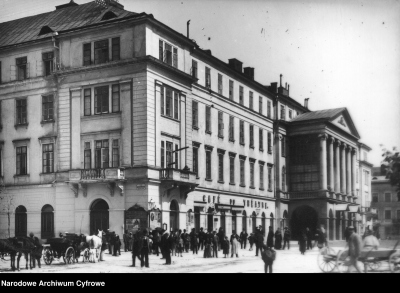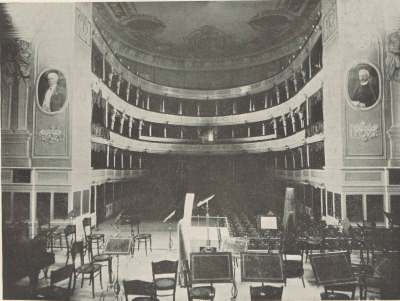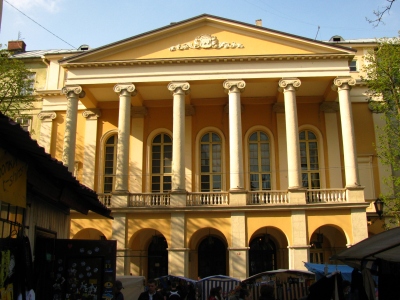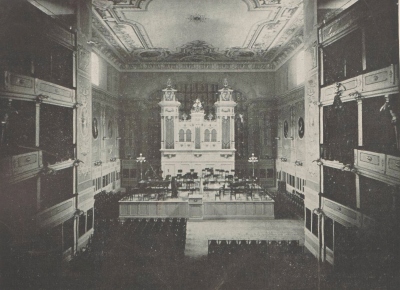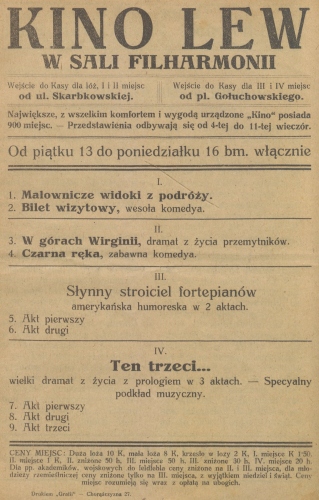Its first home was located in the renovated building of the former Skarbek Theatre from 1842, situated at 1 Skarbkowska Street, adjacent to the Grand Theatre.
The spacious hall could accommodate over 1,200 listeners. Until the construction of the Polish Music Society's concert hall in 1910, it served, together with the Grand Theatre, as the city's primary concert venue. Notably, neither of these institutions was state-owned – they relied on municipal subsidies and private donors for their operations.
The first director of the Lwów Philharmonic was Ludwik Heller, with Henryk Melcer-Szczawiński among its conductors. The year 1903 featured composer concerts by Richard Strauss, Gustav Mahler, Ruggero Leoncavallo, and Mieczysław Karłowicz. Despite a spectacular first season with 128 concerts, the philharmonic declined at the beginning of the 1903/1904 season and soon suspended its activities. In subsequent years, the philharmonic building hosted guest musician concerts organized by Maksymilian Türk's Concert Bureau (operating 1908–1939), which later also utilized the Polish Music Society's hall.
The years 1933–1939 brought about a second renaissance of the Lwów Philharmonic, this time as an institution with its own orchestra and in close collaboration with the Polish Music Society. Adam Sołtys (who had headed the Polish Music Society since 1929) became director, and in the 1938/1939 season, he was succeeded by Adam Didur, who combined the roles of opera and philharmonic director. Sołtys conducted most concerts, joined by other conductors including Jerzy Kołaczkowski (music coordinator at Polish Radio Lwów), Jarosław Leszczyński, Józef Lehrer, and Bronisław Wolfsthal. In 1936, former violinist Jakub Mund, a student of Józef Koffler, made a successful conducting debut.
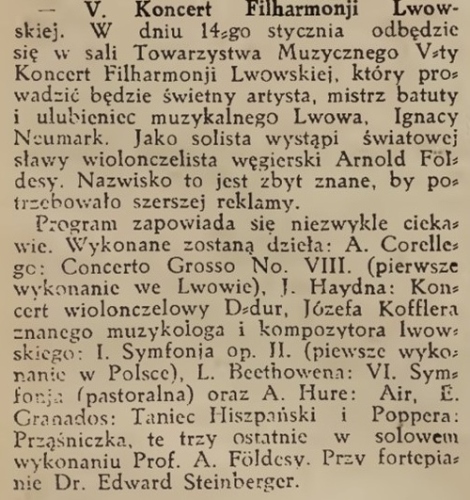



Guest conductors included Ignacy Neumark (who conducted the premiere of Koffler's Symphony No. 1 Op. 11 in 1936), Hermann Scherchen (who conducted the premiere of Koffler's Symphony No. 2 Op. 17 in 1937), as well as Walerian Bierdiajew and Feliks Nowowiejski (who conducted his own compositions). The 1933–1939 repertoire prominently featured contemporary music, including works by Polish composers such as Tadeusz Zygfryd Kassern, Józef Koffler, Roman Palester, Adam Sołtys, and Karol Szymanowski. Ukrainian composers were also represented, including Vasyl Barvinsky (Василь Барвінський) and Anton Rudnytsky (Антін Рудницький).
Despite having a spacious hall, interwar philharmonic concerts were primarily held in the Polish Music Society's hall (where the inaugural concert took place in 1933) and – with increasing frequency from 1937 – in the Grand Theatre. Meanwhile, the former philharmonic concert hall was adapted for film screenings in 1908 and equipped with sound technology in 1930. It successively housed Lwów's largest cinemas (each maintaining its own orchestra until 1930): "Urania" (1908–1911), "Lew" (1913–1931), and "Atlantic" (1931–1939).
In 1936, the Symphony No. 1 Op. 11 was performed in the Polish Music Society's hall, while the Symphony No. 2 Op. 17 was performed twice in 1937 at the Grand Theatre. The Grand Theatre also hosted Béla Bartók's composer concert in 1936, in whose preparation Józef Koffler was involved as the Philharmonic's representative, corresponding with the composer. In the same capacity, Koffler contacted Slavko Osterc, planning – though ultimately unrealized – a concert of Yugoslav composers in Lwów.
